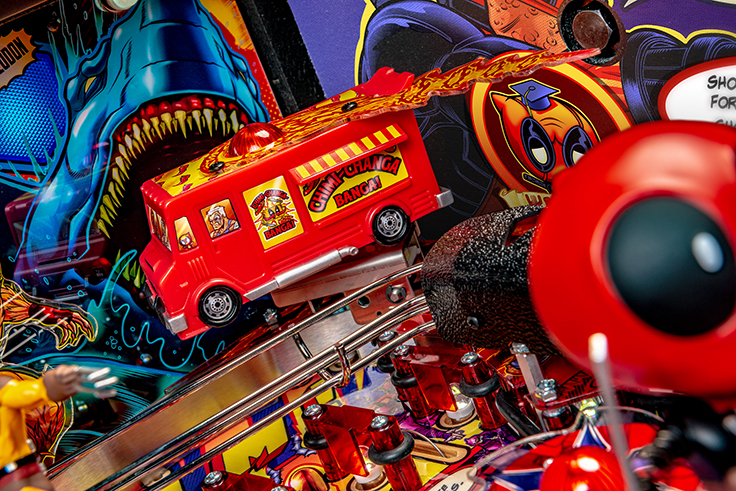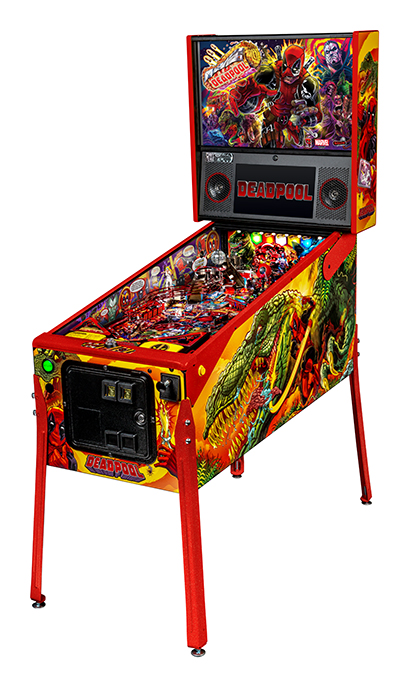 Chimichangas, Katanas, Ninjas … Oh My!
Chimichangas, Katanas, Ninjas … Oh My!
Stern Designers Reinvent the “Merc with a Mouth” in Their Genre-Bending, Laugh-Inducing Deadpool Pin
Some of the best pinball machines find a way to fuse funny with frantic flipping (think Tina Fey’s Elly May Clampet-style voice used in Williams’ classic Medieval Madness or the expertly inserted movie quips in Stern’s Ghostbusters). Stern’s latest license –– Deadpool –– is the epitome of doing just that, as the company once again teams with Marvel for a game that is sure to meld hilarity with some serious action.
“A pinball shouldn’t be a hardcore, serious thing,” said George Gomez, Stern’s chief creative officer and lead designer of the game. “It should have a lot of humor in it. The most successful pins are the ones that make players smile; make players laugh. That interaction is integral to developing the game, so with Deadpool we wrote a script that was very specific to the game and the fact you’re playing pinball. We celebrate it.
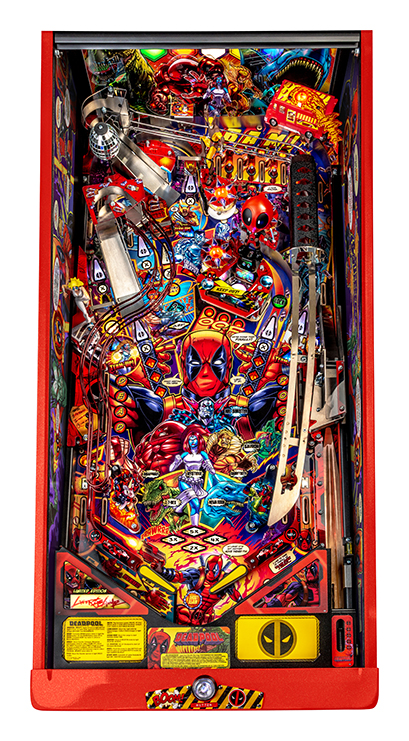 “As many times as I’ve done this, it’s always a scramble at the end,” Gomez said on the day the new pin hit Stern’s factory floor. “But it has been amazing for our sales team. So far we’ve had a lot of buzz and great reception.”
“As many times as I’ve done this, it’s always a scramble at the end,” Gomez said on the day the new pin hit Stern’s factory floor. “But it has been amazing for our sales team. So far we’ve had a lot of buzz and great reception.”
Rumors had been circulating on pinball forums for months that the company’s next pick would involve the popular Deadpool, a character that has seen enormous success in the box office and has been breaking the fourth wall since first debuting on the printed page in 1991. Stern confirmed those rumors in mid-August, releasing details on the games’ star-studded cast, innovative gameplay mechanics and flashy, comic-book inspired look.
The concept for a Deadpool machine had been mulling around the company for a few years, with work starting a little less than a year ago, Gomez said. The final design features the titular character and a host of recognizable X-Men like Wolverine, Colossus, Juggernaut, Mystique and more.
Players are thrust into the Marvel universe in its original, comic book state, not the cinematic monolith that Marvel has transformed it into. According to Gomez, this allowed the designers a hefty amount of creative control. He says the look and feel of comics fits incredibly well with pinball machines, and that, coupled with a hellish landscape of licensing needed to tap the film’s talent, convinced the company to go old school.
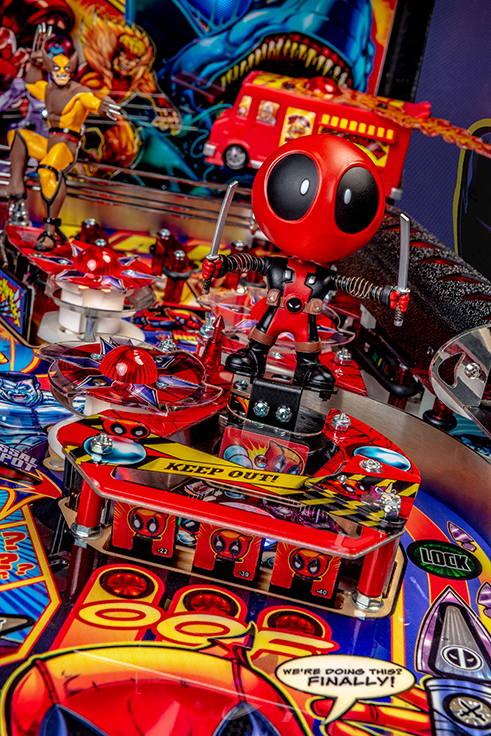 “We have a strong relationship with Marvel, and they provided us with a tremendous amount of creative freedom. It was almost like working with a completely original theme, as long as we stayed consistent with the character,” Gomez said. “Since we could do basically anything, we figured we’d do an homage to ’90s fighting games.”
“We have a strong relationship with Marvel, and they provided us with a tremendous amount of creative freedom. It was almost like working with a completely original theme, as long as we stayed consistent with the character,” Gomez said. “Since we could do basically anything, we figured we’d do an homage to ’90s fighting games.”
This plays out in a unique way on the game’s LCD display. During scenes, as players battle X-Men villains, T-Rex and giant sharks, the display emulates the look of an old CRT monitor running classic arcade fighters. This purposeful pixelation puts the player into the world the game creates, that is until the crass Deadpool pops out of the screen for an insult or taunt. Imagine fighting a gaggle of ninjas, you hit a certain shot and suddenly an HD Deadpool tears through the pixels, literally and figuratively breaking the fourth wall.
All of this is augmented by an incredible voice acting cast and the work of acclaimed script writer Brian Posehn. He has written for some of the biggest sitcoms (Friends, Seinfeld and The Big Bang Theory), and his words were brought to life by Nolan North, Brian Huskey and Jennifer LaFleur. North is the console/PC video game world’s most celebrated voice actor, taking the lead on a litany of AAA game titles, and has previously voiced Deadpool in Marvel video games. Huskey is a well-known comedic voice actor with roles on Bob’s Burgers, and plays Lil’ Deadpool in the pin. Zombie Yeti once again contributed the game’s hand-drawn art, which turns the backglass into a blazing beacon for fans of the crass antihero.
“That’s what a backglass is all about. It’s a version of the old movie poster, a billboard,” Gomez said.
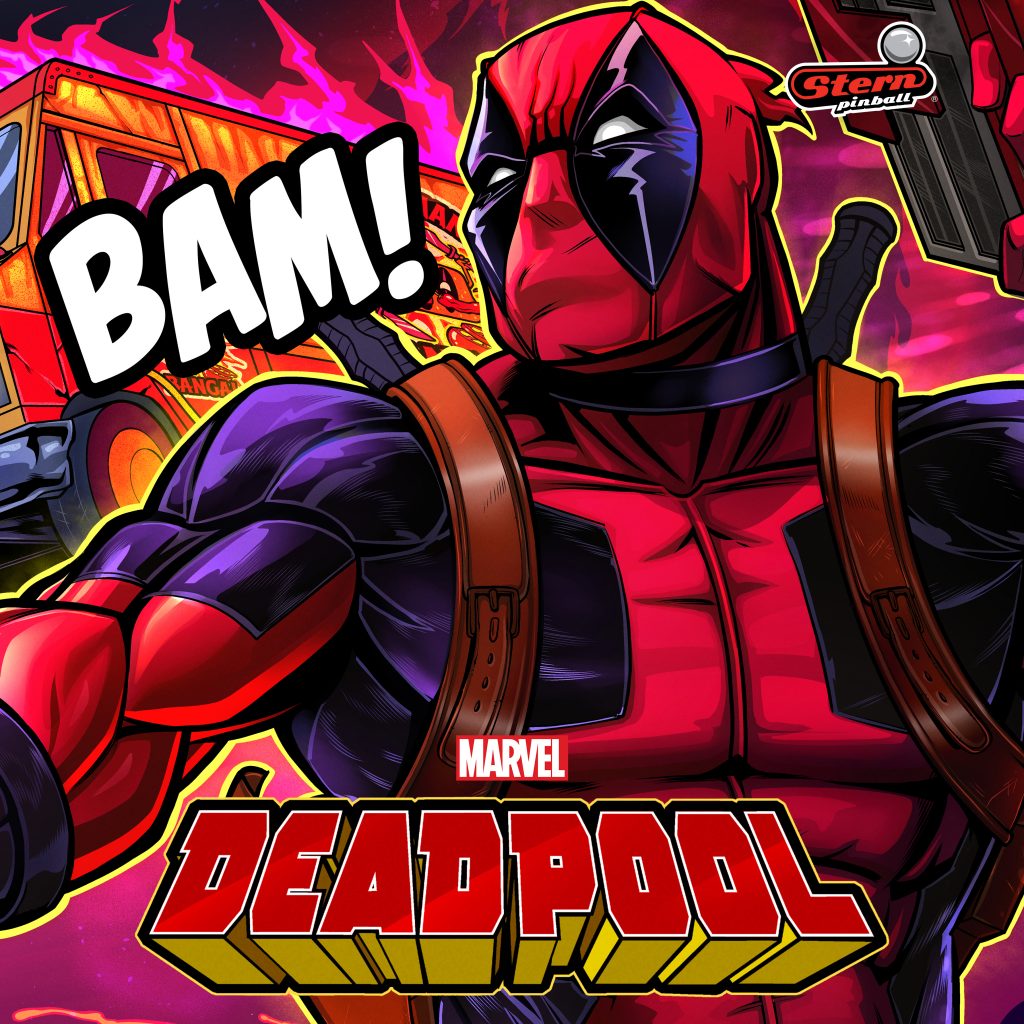 Though the Deadpool character is well known as one of the more…well, crude characters in the Marvel universe (the film and its sequel are Marvel’s only recent R-rated films), Gomez and the team at Stern knew the importance of allowing the game to appeal to a broad crowd. There was internal discussion of creating an optional “adult” mode, but that was quickly quashed by the team and Marvel.
Though the Deadpool character is well known as one of the more…well, crude characters in the Marvel universe (the film and its sequel are Marvel’s only recent R-rated films), Gomez and the team at Stern knew the importance of allowing the game to appeal to a broad crowd. There was internal discussion of creating an optional “adult” mode, but that was quickly quashed by the team and Marvel.
“We actually try to create the broadest market for our games, and we knew we could do justice to the edginess of the character,” Gomez said. “It is still very edgy. Expect to be the brunt of some jokes! The most important thing to us was ensuring that players would recognize the character, and the pin is Deadpool through and through.”
Though the design team had a heavy focus on creating an original game out of the well-known license, Stern has had a laser-focus on tapping into pop culture to ensure a well-received pinball. The company releases three titles a year, Deadpool being this year’s second (the first was based on the iconic band Iron Maiden). When asked whether, internally, the company talks about creating an original theme, Gomez said that idea always gets people excited, but logistically it’s not realistic right now.
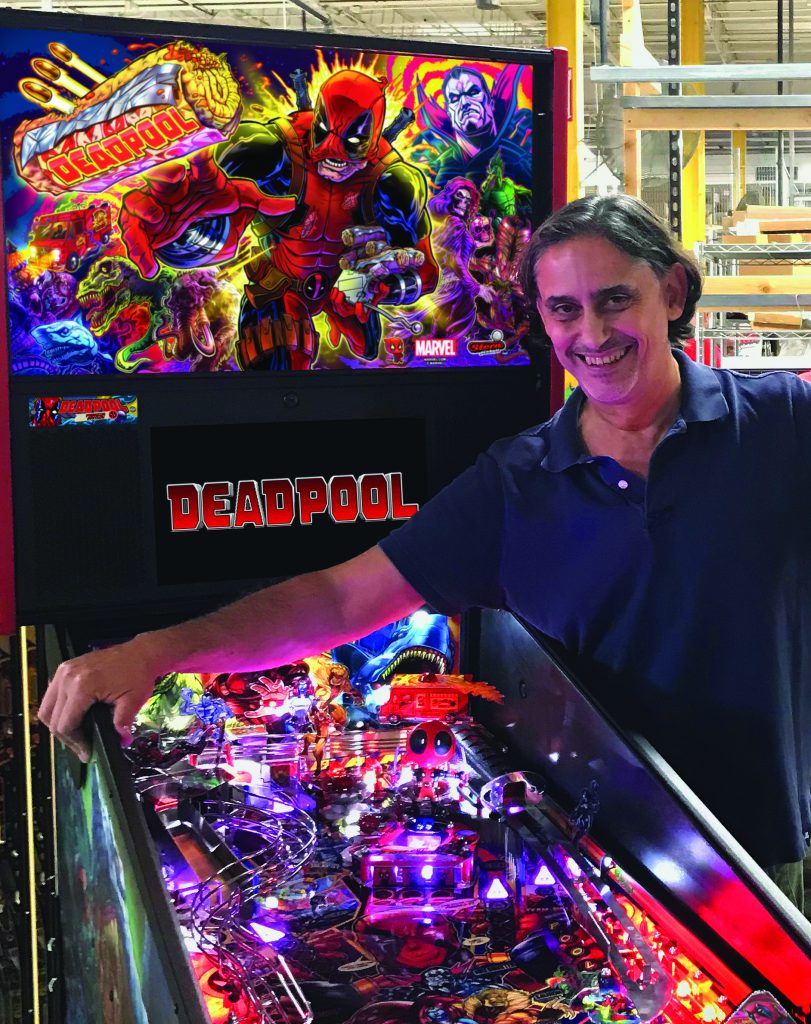
“We talk about original IP all the time, and we do have something in the works that can be considered an original theme. But honestly, even though Deadpool is a license, what gets people here excited are original ideas,” Gomez said. “We didn’t have to follow any script. We created specific music for the game and were able to do anything we wanted within the universe.”
Gomez says the challenge of an original theme as opposed to licensing is, not only do you lose the leverage of riding that licenses’ marketing coattails, it loses that instant name recognition with a large crowd. However, he says creating completely original concepts (which was commonplace in the ’80s and ’90s) may come back to the forefront of the company’s focus as the pinball industry continues its revival.
“We’ve been on a tremendous growth arc since 2009, and as we continue to grow, we can afford to take more risks,” Gomez said.
Looking forward, Gomez says Stern fans should keep a sharp eye out for a really interesting new product coming at the beginning of 2019, and another cornerstone title coming out by the end of the year.
“We’re mixing it up, working on titles that naturally follow each other, with very distinct themes,” Gomez said. “This year has been a strong one. We had a great start with Iron Maiden and from all indications Deadpool will follow strongly. I’m sure people will be excited as we end our year strong with 2018’s final title.”
For more information, go to www.sternpinball.com.
Stern Teams with Competitive Pin Pros
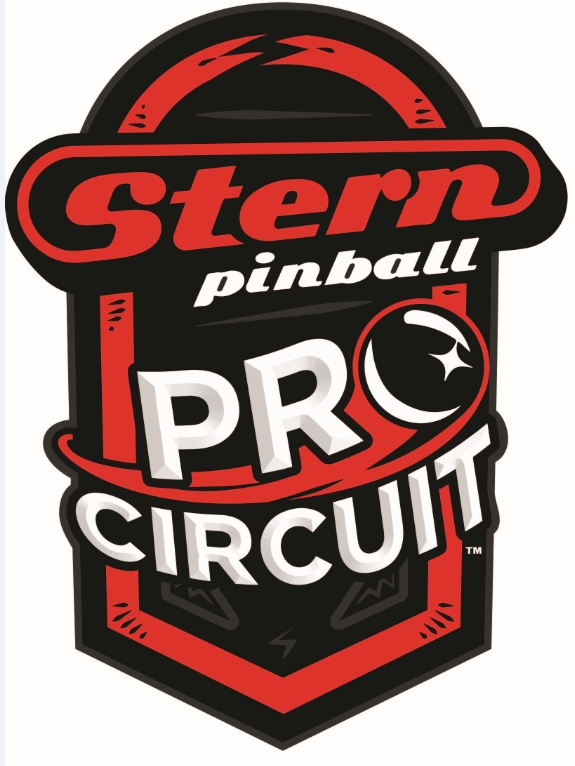 It’s not only new games that the Stern team is focused on. The company has jumped headfirst into the wild world of competitive pinball, endearing a new generation with the lights, action and fun of pinball as a true sport. News came in August that, along with the International Flipper Pinball Assoc. (IFPA) and the Replay Foundation (not associated with RePlay Magazine), Stern would establish a new 20 tournament program: the Stern Pro Circuit. By Spring of 2019, 40 top players will head for the championship last-man-standing final tourney in Chicago.
It’s not only new games that the Stern team is focused on. The company has jumped headfirst into the wild world of competitive pinball, endearing a new generation with the lights, action and fun of pinball as a true sport. News came in August that, along with the International Flipper Pinball Assoc. (IFPA) and the Replay Foundation (not associated with RePlay Magazine), Stern would establish a new 20 tournament program: the Stern Pro Circuit. By Spring of 2019, 40 top players will head for the championship last-man-standing final tourney in Chicago.
“Stern Pinball and the IFPA are both leaders in different aspects of the pinball industry, and the Replay Foundation is excited to collaborate with both of them,” said Mark Steinman, Director of Operations at the Replay Foundation. “The Stern Pro Circuit will help elevate competitive pinball to even greater heights, and we’re looking forward to the positive impact that it will have on the pinball community.”
A whopping $500,000 in cash and prizes will be up for grabs throughout the tournament, with qualifying tournaments held in the U.S. and Denmark. Zach Sharpe, director of marketing at Stern, said the concept is focused on diehard pin players, but the company also promotes growth for more friendly competition. In 2016, the nationwide grassroots support for competitive pinball materialized into the Stern Army. This group helps organize leagues, tournaments and special pinball events all over the country, and has seen yearly growth since it was formalized by Stern. Today, over 111 locations host members of the Stern Army, massive growth since the original 14 locations in 2016.
“Both diehard and casual competition helps the concept of pinball grow to new people,” Sharpe said. “It gets more people involved and aware of the sport, more people in locations and at shows. It ties together everything that feeds the beast of Stern Pinball.”
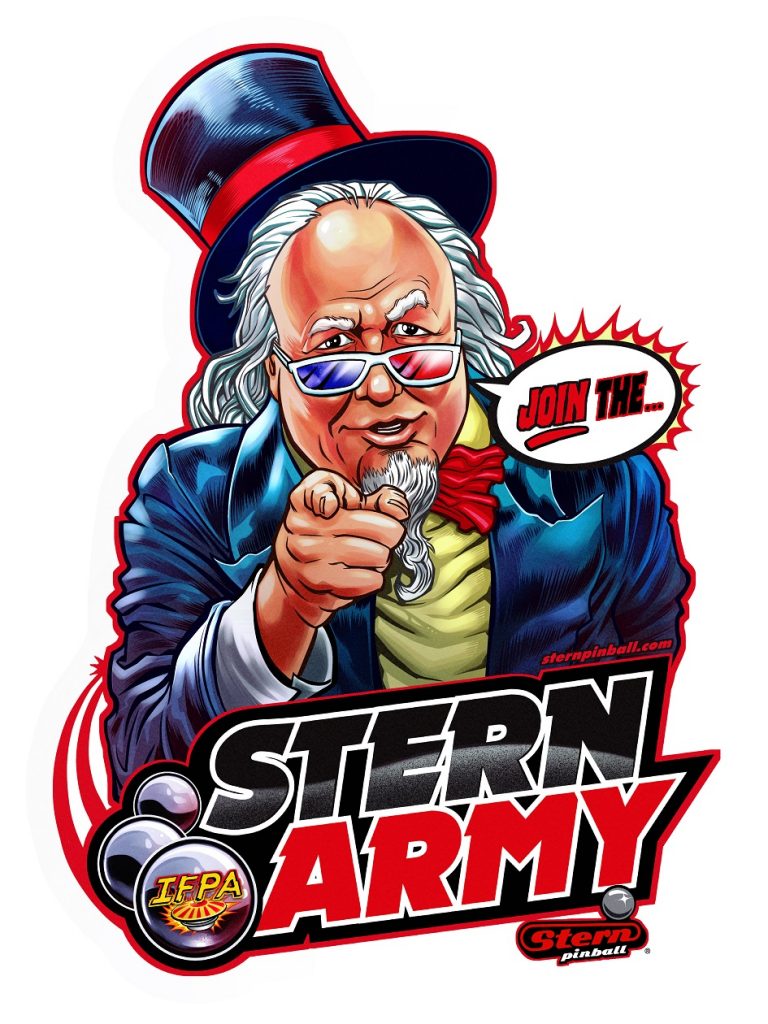 Sharpe was excited to report that alongside the growth that pinball has seen in the last few years, the demographics are changing as well. In the last two years the sport has seen growth among women and younger crowds, a fact well emphasized when looking at last year’s Professional and Amateur Pinball Assoc. (PAPA) world champion. Escher Lefkoff, a 13-year-old wizard from Colorado, won the Division A title to take home the title.
Sharpe was excited to report that alongside the growth that pinball has seen in the last few years, the demographics are changing as well. In the last two years the sport has seen growth among women and younger crowds, a fact well emphasized when looking at last year’s Professional and Amateur Pinball Assoc. (PAPA) world champion. Escher Lefkoff, a 13-year-old wizard from Colorado, won the Division A title to take home the title.
Pinball, which some could argue is the world’s first real eSport, is a great spectator sport as well, and Stern knows that well. The company has done livestreams with partners like Jack Danger, a Twitch personality, and big tournaments can have thousands watching live from around the world. On top of that, successful pinball leagues bring hordes of avid players (and beer drinkers!) into bars and other locations that host them, meaning slow nights can transform into raucous, wall-to-wall competitions.
“Stern wants pinball to keep getting bigger and better every year,” Sharpe said. “We want, say five years from now, final competitions held in the center of an arena packed with fans.”
Looking at the trends of eSports in general, this fantasy isn’t far from reality. As the trend gains popularity, and if pinball continues to grow at the rate it has been, we may see head-to-head competitions in eSports arenas all over. However, none of it can happen without local pin leagues supported by entrepreneurial operators, Stern and enthusiastic pinheads.

